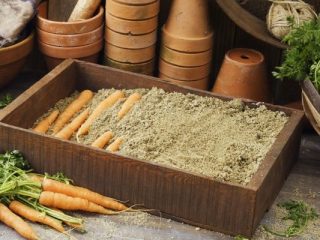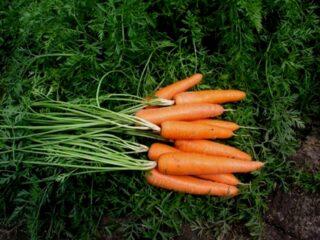For cultivation in domestic latitudes, farmers are offered various varieties and hybrids of carrots, including foreign selection. Moreover, hybrids obtained by crossing two varieties combine the best qualities of their ancestors. Thus, some of them have amazing taste and external characteristics, high resistance to diseases, cold, and suitability for long-term storage. One of the best hybrids is the Bangor F1 carrot. The main characteristics of this variety, taste and external description and photo of the root crop are given in the article.
Description of the hybrid
The carrot variety "Bangor F1" was bred by the Dutch breeding company Bejo. According to the external description, the hybrid is classified as the “Berlicum” variety, since the root crop has a cylindrical shape with a rounded tip. Its length is in the range of 16-20 cm, weight is 120-200 g. In cross section, the diameter of the root crop is 3-5 mm. You can evaluate the external qualities of carrots of the “Bangor F1” variety in the photo below.
100 g of Bangor F1 carrots contain:
- 10.5% dry matter;
- 6% total sugar;
- 10 mg carotene.
In addition to the main substances, carrots contain a complex of vitamins and microelements: B vitamins, panthethonic and ascorbic acids, flavonoids, anthocyanins, fatty and essential oils.
The microelement composition affects the external and taste qualities of the root crop.Thus, a relatively high amount of carotene gives the root vegetable an orange-red color. The pulp of Bangor F1 carrots is very juicy, sweet, and moderately dense. The root crop of this variety is used in the preparation of fresh vegetable salads, canning, the production of baby and dietary food, and multi-vitamin juices.
Agricultural technology
The variety "Bangor F1" is zoned for the Central region of Russia. It is recommended to sow it in April, when the likelihood of frosts and prolonged cold spells has passed. Loose sandy loams and light loams are best suited for cultivating vegetables. The required soil composition can be prepared by mixing the soil available on the land plot with sand, humus, and peat. Sawdust treated with urea should be added to heavy clay. The depth of the arable layer for growing the Bangor F1 variety must be at least 25 cm.
Carrot seeds should be sown in rows. The distance between them should be at least 15 cm. It is recommended to maintain a 4 cm interval between seeds in the same row. To maintain the required distance, it is recommended to use special tapes with seeds or glue them yourself onto paper analogues. If the required intervals are not observed, it is necessary to thin out the carrots 2 weeks after emergence. The depth of planting the seed should be 1-2 cm.
During the growing process, the crop requires systematic watering. In this case, the depth of soil saturation should be greater than the length of the root crop. All necessary fertilizers should be added to the soil in the fall, which will eliminate the need for additional fertilizing.To combat carrot flies (if necessary), during the cultivation process, you can treat with ash, tobacco dust, wormwood, or special agrotechnical chemicals. By watching the video you can learn in detail about the agrotechnical features of growing carrots:
Under favorable growing conditions, carrots of the Bangor F1 variety ripen 110 days after sowing the seed. Crop yield largely depends on the nutritional value of the soil, compliance with cultivation rules and can vary from 5 to 7 kg/m2.










